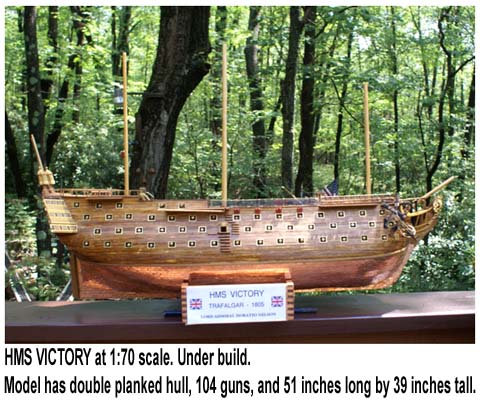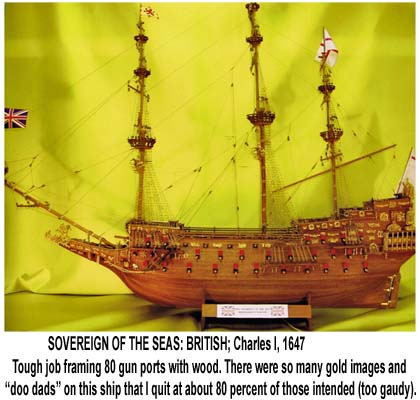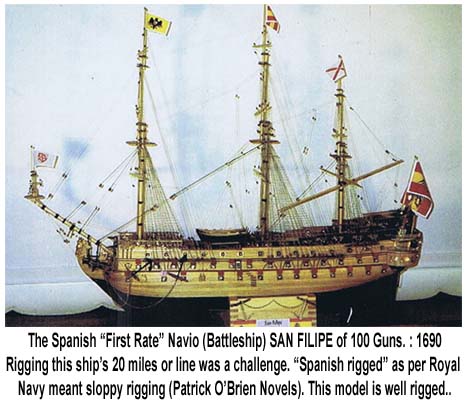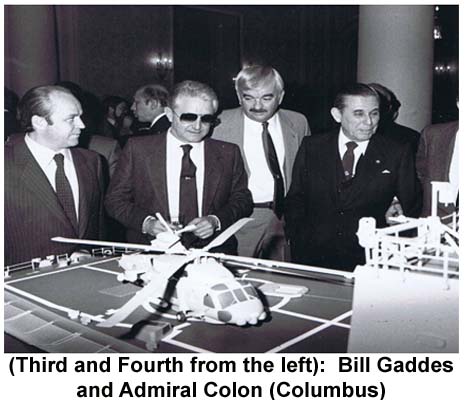GUNNERY ABOARD THE 100 GUN “MAN-O-WAR”: 1750-1812
The “Man-O-War” was a gun platform. A “First Rate” carried 100 guns. Tables One and Two show the evolution of gunnery technology over HMS Victory’s life span.
Table One. HMS VICTORY’s Gunnery Evolution: 1757 through 1812.
YEAR 1760 1782 1805 Trafalgar
Quarterdeck 10 ea. 6 lbs.(1) 10 ea. 12 lbs. 12 ea. 12 lbs.
Main Deck Fwd. 2 ea. 6 lbs. 2 ea. 12 lbs. 2 ea. 12 lbs.
Forecastle none none 2 ea carronades,68 lbs (2)
Top gun Deck 30 ea. 12 lb. same same
Mid Gun Deck 28 ea. 24 lbs. same same
Lower Gun Deck 30 ea. 42 lb 30 ea. 42 lb. 30 ea. 32 lb. (4)
Broadside Weight (lbs.) 1,182 (3) 1,290 1,148
(1) lbs. = “pounder”or weight of ball. (2) Carronade introduced for very short range
(3) VICTORY could release a broadside every 2.5 minutes.
(4) Going from 42 to 32 pounders saved 170 tons on lower gun deck; plus 150 gunners, and 15 “power monkeys”..
Table Two. Gun Size, Muzzle Vel. Max. Range, Powder Req’d., Crew Size .
SIZE MUZZLE VEL. RANGE POWDER (per gun) CREW SIZE
32 Pounder 1500 ft./sec. 2400 yds. 10 lbs. 15
24 Pounder 1000 “ 1300 yds. 8 lbs. 12
12 Pounder 500 “ 700 yds. 4 lbs. 10
68 lb. Carronade 550 “ 200 yds. 20 lbs. 6
Through the life of VICTORY, it was necessary to close on the enemy. By 1800, brass guns were gone, replaced by iron guns with slightly longer range. Rigid discipline and practice yielded superior Royal Navy gunnery performance. By 1820, the very complex 100 gun sailing ship was disappearing in favor of screw and paddle wheel ships.
If one wishes to read about these ships, the 19 novels by Patrick O’Brien about Captain Aubrey of the Royal Navy are outstanding. The US Naval Academy at Annapolis MD has a wonderful collection of more than 150 priceless and historic ship models, many dating back to the 1700’s. I highly recommend a visit to this museum. Those interested in modeling a ship from this era may contact Bill Gaddes at 570-645-2762; e-mail dag2010@windstream.net.
Bill Gaddes
B-29/WB-29 Tail Gunner
Shipwright: June 24, 2011

 Atlantic coast of Spain, not far from the city of Cadiz. This epic battle pitted the British fleet under Admiral Horatio Nelson against the combined fleets of France and Spain. The British fleet sailed into battle under the message flags stating “England Expects Every Man Will Do His Duty”; ultimately scoring a tremendous victory. However, Lord Admiral Nelson, standing on the quarterdeck of HMS VICTORY in full regalia, lost his life to a French sharpshooter in the rigging of a French 74 gun ship alongside; the “Redoubtable”..
Atlantic coast of Spain, not far from the city of Cadiz. This epic battle pitted the British fleet under Admiral Horatio Nelson against the combined fleets of France and Spain. The British fleet sailed into battle under the message flags stating “England Expects Every Man Will Do His Duty”; ultimately scoring a tremendous victory. However, Lord Admiral Nelson, standing on the quarterdeck of HMS VICTORY in full regalia, lost his life to a French sharpshooter in the rigging of a French 74 gun ship alongside; the “Redoubtable”.. ship, heavily clad in gold fittings and figures, be named SOVEREIGN OF THE SEAS in his honor. He agreed, but directed that the model remain in his chambers. Now they had to clad the ship in gold. At a time when a 100 gun Man-O-war cost 5,000 Pounds, SOVEREIGN cost 45,000 Pounds. Even today, this ship cost more “per capita” than any other naval ship, including all of our super aircraft carriers. Eisenhower’s ‘Military-Industrial Complex’ existed long before his Presidency. The US Naval Academy Museum has a large model of SOVEREIGN OF THE SEAS. This model rested atop Lord Nelson’s casket in Saint Paul’s Cathedral in London during his burial service in November of 1805.
ship, heavily clad in gold fittings and figures, be named SOVEREIGN OF THE SEAS in his honor. He agreed, but directed that the model remain in his chambers. Now they had to clad the ship in gold. At a time when a 100 gun Man-O-war cost 5,000 Pounds, SOVEREIGN cost 45,000 Pounds. Even today, this ship cost more “per capita” than any other naval ship, including all of our super aircraft carriers. Eisenhower’s ‘Military-Industrial Complex’ existed long before his Presidency. The US Naval Academy Museum has a large model of SOVEREIGN OF THE SEAS. This model rested atop Lord Nelson’s casket in Saint Paul’s Cathedral in London during his burial service in November of 1805. capable of building first rate, high quality ships of incredible firepower and great beauty. However, in combat with British ships, they were the victim of greater gunnery accuracy and more rapid fire rates. Apparently this was the p
capable of building first rate, high quality ships of incredible firepower and great beauty. However, in combat with British ships, they were the victim of greater gunnery accuracy and more rapid fire rates. Apparently this was the p of Columbus. .(third and fourth from the left): Bill Gaddes and Admiral Colon (Columbus) when IBM presented a model of the LAMPS MK III capable Spanish Navy frigate “NUMANCIA” to the Museo Naval in Madrid):1985. Gaddes detailed the ship and SH-60B models.
of Columbus. .(third and fourth from the left): Bill Gaddes and Admiral Colon (Columbus) when IBM presented a model of the LAMPS MK III capable Spanish Navy frigate “NUMANCIA” to the Museo Naval in Madrid):1985. Gaddes detailed the ship and SH-60B models.